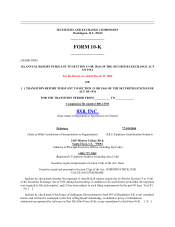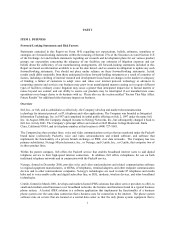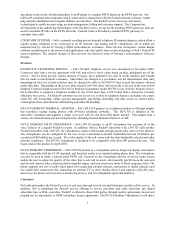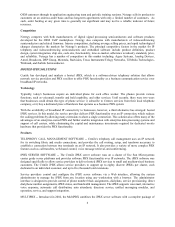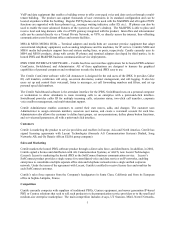8x8 2003 Annual Report Download - page 7
Download and view the complete annual report
Please find page 7 of the 2003 8x8 annual report below. You can navigate through the pages in the report by either clicking on the pages listed below, or by using the keyword search tool below to find specific information within the annual report.4
to end-users from 8x8’s website, as well as through distributors and value-added resellers.
Sales and Marketing
8x8 markets the Packet8 IP services via its own direct sales force and through third-party resellers. 8x8 markets its
consumer systems through its direct sales force and third-party resellers. Sales of the products to end-users are also
conducted from 8x8’s website.
Competition
Competitors for the Packet8 service include Vonage, Net2Phone and iConnectHere and Voice Pulse, as well as
incumbent telephone carriers, and other providers of traditional and legacy telephone service. 8x8’s consumer
systems products compete with other providers of videophones and videoconferencing systems, including Vialta,
Inc., Innomedia, MotionMedia, and various software offerings that implement videophone functionality on a
personal computer. Principal competitive factors in the market for 8x8's products include product feature parity,
interface design, product reliability, performance, time-to-market, adherence to standards, price, functionality,
customer service and IP network delivery/design.
SEMICONDUCTORS AND EMBEDDED SOFTWARE
Netergy develops and markets a range of technology products, including semiconductors, embedded software,
system software, and reference designs, that allow telecommunication equipment OEMs to: i) build voice and video
IP phones, ii) build IP-to-analog phone adapter products, and iii) add IP telephony functions to DSL, cable, and
wireless modems. Additionally, Netergy provides semiconductors and embedded software for use in
videoconferencing applications.
Technology
SEMICONDUCTOR ARCHITECTURE -- Netergy's semiconductors are based on programmable processor
architectures that enable implementation of IP telephony and videoconferencing applications in a highly efficient
manner. Netergy's semiconductor architectures employ 32-bit reduced instruction set computing, or RISC,
microprocessor cores, which execute the embedded applications software. Some of Netergy's semiconductors also
employ a 64-bit Single Instruction Multiple Data, or SIMD, digital signal processor, or DSP, to accelerate the
execution of signal processing intensive operations. Furthermore, Netergy's Audacity-T2 and T2U semiconductors
benefit from the unique feature of not requiring any external SRAM or DRAM to operate.
EMBEDDED SOFTWARE -- Netergy has developed a broad range of embedded application software that runs on
its semiconductor products. Netergy's application software allows the use of its semiconductors in systems that
conform to various emerging and established international telephony standards for audio and video encoders and
decoders (also known as codecs) and call signaling protocols. By refining its software, Netergy can enhance quality,
address new standards, and add significant features and functionality to systems that contain the semiconductor
products. In addition, certain customers have licensed source code to which they add proprietary features and
custom interfaces and, in some cases, port to other semiconductor or processor architectures.
Call signaling protocol stacks are complex software programs required to make voice calls over IP networks,
including the internet. Codecs format and compress digital audio and video signals so they can be represented and
efficiently transmitted in a digital form. Developing functional VoIP and video software and obtaining
interoperability with other VoIP and video systems requires significant development time, which is why many
OEMs choose to license it. Netergy's protocol stacks support the four most commonly deployed VoIP protocols,
along with seven codecs.
Netergy is also developing new video compression algorithm technology based on the H.264 (formerly called
H.26L) standard. The H.264 standard is a new set of algorithms being jointly specified by standards bodies in the
International Teleconferencing Union, or ITU, and the Moving Pictures Expert Group, or MPEG, with the goal of
improving video compression ratios by a factor of two versus any current video algorithm specification at any bit
rate. For a given bit rate, implementations of the new H.264 video codec are expected to improve the picture quality
of video streaming, telephony, and entertainment applications beyond the quality of pictures that are available today
from either the MPEG-2 or MPEG-4 algorithms.

